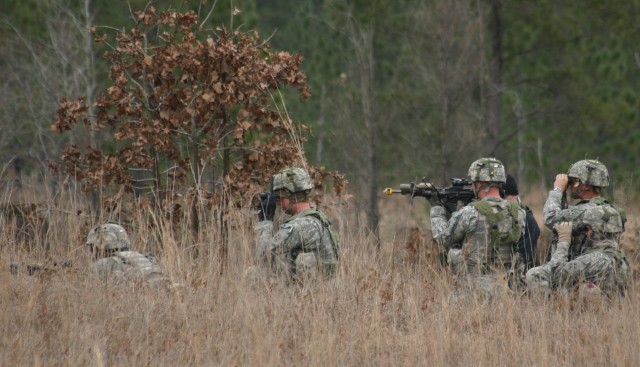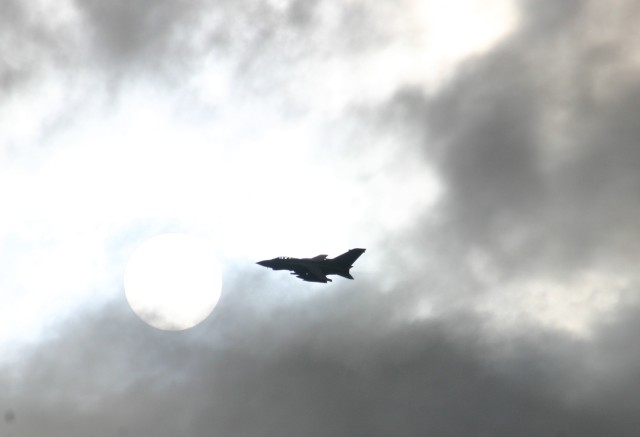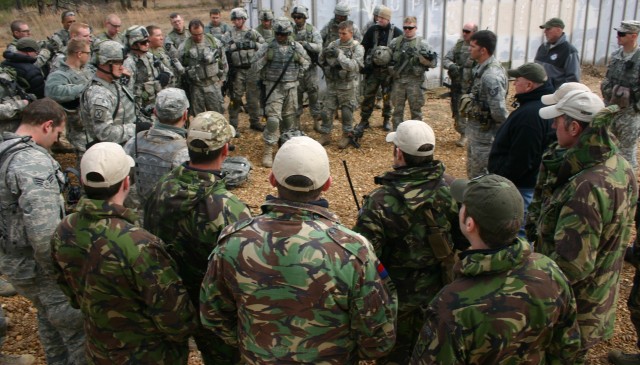FORT POLK, La. (Army News Service, Jan. 23, 2009) - U.S. Soldiers, Airmen and British troops are practicing their joint warfighting skills in preparation for an upcoming deployment to Afghanistan.
The U.S. Army's 4th Brigade Combat Team, 4th Infantry Division from Fort Carson, Colo., is conducting its mission rehearsal exercise at Fort Polk in preparation for its deployment later this year.
Part of the training is focused on improving the close air support skills of the Army joint fires observers and U.S. Air Force and British joint terminal attack controllers supporting the 4th BCT.
Assisted by the Operations Group, Joint Readiness Training Center, the Air Force's Green Flag East, and U.S. Joint Forces Command's Joint Fires Integration and Interoperability Team, the 4th BCT is honing critical skills.
"JRTC and Green Flag East have done a superb job of enhancing CAS training for Army, Air Force, and coalition units as they prepare for the challenges that lie ahead once deployed in combat," said Navy Lt. Cmdr. Chris Olson, JFIIT lead at JRTC.
"Our job is to help integrate those assets and bridge the gaps between the services so they can improve their combat effectiveness while reducing the potential of fratricide and collateral damage on a very fluid and ever-changing battlefield," Olson said.
Part of this joint CAS training involves integrating coalition assets like the British Tornado GR-4 aircraft from the Royal Air Force Station Lossiemouth in Scotland.
"Our training at JRTC has been excellent," said Air Force Sgt. Clinton Herblson, 4th BCT JTAC from the 13th Air Support Operations Squadron at Fort Carson. "The realistic training that we're receiving here will prepare us for the conditions we'll face once in country. Plus, the opportunity to work with our British counterparts is priceless - something that we normally wouldn't experience until we were actually deployed."
JRTC employs joint assets to provide realistic and rigorous training that replicates the operational environment found in Afghanistan and Iraq.
"The opportunity to train alongside other services and our coalition partners can't be overstated," said Army 2nd Lt. Gabriel Dearman, fire support officer, Delta Company, 2-12 Infantry, 4th BCT, 4th ID. "This is the first time that we've had the chance to experience this level of training ... it's taken our air-to-ground skills to a whole new level of proficiency."
Army Sgt. Clint Inderbitzen, JFO from Charlie Company, 2-12 Infantry, 4th BCT, 4th ID couldn't agree more. "The training we receive at home station is good, but the opportunity to train here with so many different assets, like the British pilots flying the GR-4s, will only help us to execute our mission better once we're deployed."
Army Sgt. 1st Class Bryan Lever, JRTC fire support training mentor, said the ability to provide JTACs and JFOs an opportunity to plan and execute a realistic mission in a live environment with many of the same assets they will have once in theater is crucial to the unit's success.
"Coaching, teaching, and mentoring Soldiers how to fully utilize all the capabilities at their disposal is an important part of what we do," Lever said. "We're teaching fire supporters how to better execute multiple aspects of their mission, whether it's lethal or non-lethal effects that are needed by the maneuver commander."
The need for BCTs to continue honing their joint air-to-ground skills is an important part of their training mission at home station and in other training events, according to JRTC, Green Flag East, and JFIIT leaders.
"BCTs need to become very familiar with what their Air Force JTACs and other joint assets can do to help the ground commander execute their mission more efficiently and effectively," said Army Sgt. 1st Class Corey Ingram, lead fire support planner for JFIIT. "JTACs and JFOs working closely together at home station and in a JRTC training environment will build confidence in the entire fires team, which will pay huge dividends once they're deployed."
The benefits to this enhanced joint training environment have become evident to many of the leaders and soldiers training here.
"JRTC has provided us with the best training that we've ever received," said Dearman. "From integrating numerous joint and coalition assets to allowing us to use and implement what we've learned from school and home station - we're not perfect, but I think we're getting better every day."
(Casey E. Bain serves as public affairs officer for JFIIT, U.S. Joint Forces Command)






Social Sharing